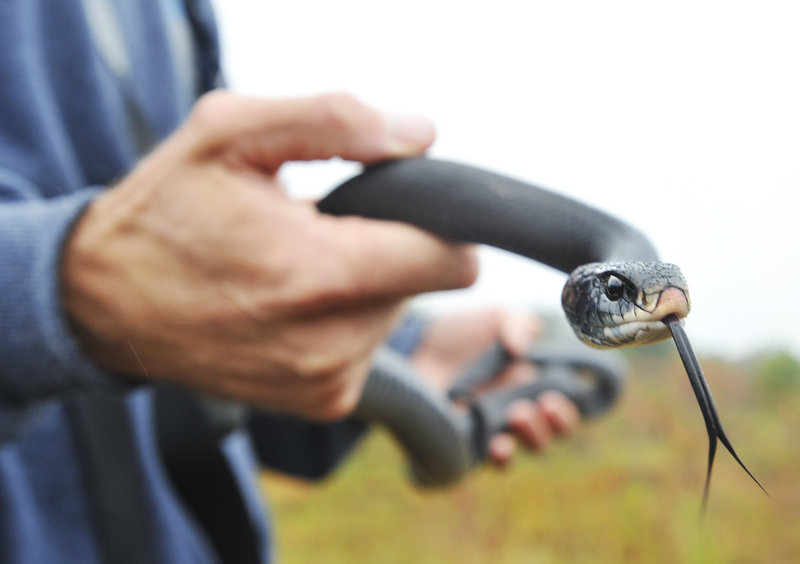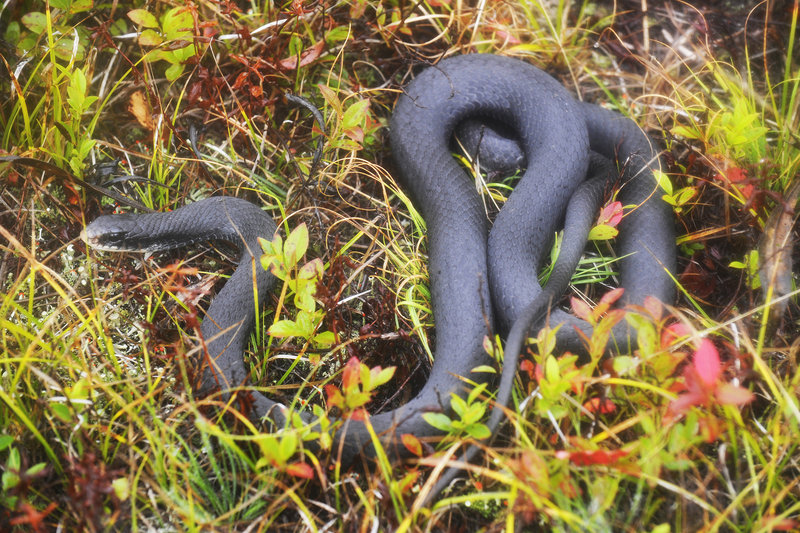WELLS — On a cool, rainy Monday, most of the black racer snakes that live in the Wells Barren were coiled up tight under a blueberry bush.
But not the four specimens that Trevor Persons carried in bags for release.
Those black racers had been collected the previous weekend, when the weather was warm and the snakes were moving. They were weighed, measured and marked.
Persons, a herpetologist with the state Department of Inland Fisheries and Wildlife, and Parker Schuerman, the Wells Barren’s preserve manager, went back to the barren Monday to return the snakes and close the traps where they had been captured.
The black racer snake is common in the South but it’s an endangered species in Maine, the northern end of its range. Biologists have been studying the snakes to better understand where they are living and why they are so rare.
They knew little about black racers in Maine until plans were introduced in late 2004 for a Walmart Supercenter and a Lowe’s hardware store in Sanford. The snakes were found to be living on the building site.
The developer was required, in the permitting process, to take steps to mitigate the impact of the new buildings, roads and parking lots on the snakes, said Jonathan Mays, a wildlife biologist with the fisheries and wildlife agency.
Fences were erected to keep the snakes out of the construction area. For every acre of black racer habitat that was taken, the developer had to buy 8 acres of nearby land for preservation.Mays said it became clear that much was unknown about black racers and their habitat. Since then, researchers have learned much about the snake, which grows to as long as 5 to 6 feet in Maine, making it the largest snake to inhabit the state.
Inland Fisheries and Wildlife teamed up with the Nature Conservancy, a private conservation group, to study the black racer population in the Wells Barren. The 560-acre preserve, and the adjacent Kennebunk Plains Wildlife Management Area, is where a retreating continental glacier dropped its load of sand thousands of years ago.
The barren may be home to the largest black racer population in Maine. It is one of the few spots in Maine where the snakes have been documented. So far, none has been found outside York County, except for some specimens collected in the 1800s in the Lewiston area. But the provenance of those specimens, now held by Harvard University, is shaky, Mays said.
The snake is black on top with a dark gray underbelly. It is not poisonous, but it does bite.
“Their bite feels like being scratched by a blackberry bramble,” Schuerman said.
During the first two years of the study, biologists implanted radio transmitters in 14 black racers to follow their movements. They learned that the snakes hibernate in underground burrows in one small area of the barren, and emerge to mate and lay eggs in the spring.
Then they fan out across the land. They can travel as far as two miles a day. But most don’t move more than 500 feet a day as they hunt for food, which includes shrews, insects, smaller snakes and even chipmunks.
About this time in the fall, the snakes return to their hibernation area amid red-leafed wild blueberry bushes and periwinkle aster.
Mays, the head researcher for the project, said it appears there are several hundred black racers living in the barren, but researchers are still collecting data for their count.
The researchers hope to raise grant money to look at black racers in areas of York County that are less hospitable than the undisturbed barren.
“It depends on whether we can find another population to study,” Mays said.
Staff Writer Beth Quimby can be contacted at 791-6363 or at:
bquimby@pressherald.com
Copy the Story Link
Send questions/comments to the editors.





Success. Please wait for the page to reload. If the page does not reload within 5 seconds, please refresh the page.
Enter your email and password to access comments.
Hi, to comment on stories you must . This profile is in addition to your subscription and website login.
Already have a commenting profile? .
Invalid username/password.
Please check your email to confirm and complete your registration.
Only subscribers are eligible to post comments. Please subscribe or login first for digital access. Here’s why.
Use the form below to reset your password. When you've submitted your account email, we will send an email with a reset code.